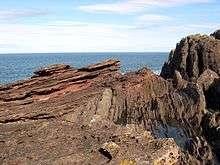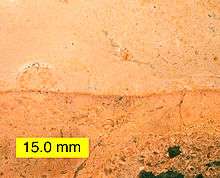Unconformity
An unconformity is a buried erosional or non-depositional surface separating two rock masses or strata of different ages, indicating that sediment deposition was not continuous. In general, the older layer was exposed to erosion for an interval of time before deposition of the younger layer, but the term is used to describe any break in the sedimentary geologic record. The significance of angular unconformity (see below) was shown by James Hutton, who found examples of Hutton's Unconformity at Jedburgh in 1787 and at Siccar Point in 1788.[1][2]

The rocks above an unconformity are younger than the rocks beneath (unless the sequence has been overturned). An unconformity represents time during which no sediments were preserved in a region. The local record for that time interval is missing and geologists must use other clues to discover that part of the geologic history of that area. The interval of geologic time not represented is called a hiatus. It is a kind of relative dating.
Types
Disconformity

A disconformity is an unconformity between parallel layers of sedimentary rocks which represents a period of erosion or non-deposition.[3] Disconformities are marked by features of subaerial erosion. This type of erosion can leave channels and paleosols in the rock record.[4]
Nonconformity

A nonconformity exists between sedimentary rocks and metamorphic or igneous rocks when the sedimentary rock lies above and was deposited on the pre-existing and eroded metamorphic or igneous rock. Namely, if the rock below the break is igneous or has lost its bedding due to metamorphism, the plane of juncture is a nonconformity.[5]
Angular unconformity

An angular unconformity is an unconformity where horizontally parallel strata of sedimentary rock are deposited on tilted and eroded layers, producing an angular discordance with the overlying horizontal layers. The whole sequence may later be deformed and tilted by further orogenic activity. A typical case history is presented by the paleotectonic evolution of the Briançonnais realm (Swiss and French Prealps) during the Jurassic.[6][7]
Paraconformity

A paraconformity is a type of unconformity in which strata are parallel; there is no apparent erosion and the unconformity surface resembles a simple bedding plane. It is also called nondepositional unconformity or pseudoconformity.[8][9] Short paraconformities are called diastems.
Buttress unconformity
A buttress unconformity occurs when younger bedding is deposited against older strata thus influencing its bedding structure.[10]
Gallery
 There is a billion-year gap in the geologic record where this 500-million-year-old dolomite nonconformably overlies 1.5-billion-year-old rhyolite, near Taum Sauk Hydroelectric Power Station, Missouri.
There is a billion-year gap in the geologic record where this 500-million-year-old dolomite nonconformably overlies 1.5-billion-year-old rhyolite, near Taum Sauk Hydroelectric Power Station, Missouri.- The Taconic Unconformity near Catskill, New York. This angular unconformity separates the Austin Glen Formation (Ordovician) from the overlying Rondout Formation (Silurian) and Manlius Formation (Devonian).
- Eemian disconformity in a fossil coral reef on Great Inagua, The Bahamas. Foreground shows corals truncated by erosion; behind the geologist is a post-erosion coral pillar which grew on the disconformity after sea level rose again.
 Hutton's angular unconformity at Siccar Point where 345-million-year-old Devonian Old Red Sandstone overlies 425-million-year-old Silurian greywacke.[12]
Hutton's angular unconformity at Siccar Point where 345-million-year-old Devonian Old Red Sandstone overlies 425-million-year-old Silurian greywacke.[12] Disconformity with the Lower Cretaceous Edwards Formation overlying a Lower Permian limestone; hiatus is about 165 million years; Texas.
Disconformity with the Lower Cretaceous Edwards Formation overlying a Lower Permian limestone; hiatus is about 165 million years; Texas. Nonconformity between the Pennsylvanian Fountain Formation (left) and Precambrian gneiss (right) at Red Rocks Park, near Golden, Colorado
Nonconformity between the Pennsylvanian Fountain Formation (left) and Precambrian gneiss (right) at Red Rocks Park, near Golden, Colorado Disconformity (at the hammer) between underlying Mississippian Borden Formation and overlying Pennsylvanian Sharon Conglomerate, near Jackson, Ohio
Disconformity (at the hammer) between underlying Mississippian Borden Formation and overlying Pennsylvanian Sharon Conglomerate, near Jackson, Ohio Angular unconformity of Triassic rocks overlying steeply-tilted Carboniferous rocks at Praia do Telheiro, Portugal
Angular unconformity of Triassic rocks overlying steeply-tilted Carboniferous rocks at Praia do Telheiro, Portugal Angular unconformity between the underlying Docker Group and the overlying Exeter Formation. Steamboat Butte in the valley of the Dry Cimmarron.
Angular unconformity between the underlying Docker Group and the overlying Exeter Formation. Steamboat Butte in the valley of the Dry Cimmarron.
References
- Hutton's Unconformity Archived 2015-09-24 at the Wayback Machine
- Keith Montgomery (2003). "Siccar Point and Teaching the History of Geology" (pdf). University of Wisconsin. Retrieved 2015-03-16.
- Monroe J.S., Wicander R. & Hazlett R.W. (2007). Physical geology: exploring the Earth. Cengage Learning. p. 267. ISBN 9780495011484.
- Disconformity at EPGeology
- Stokes, W. Lee (1982). Essentials of Earth History 4th Edition. Prentice Hall,Inc. p. 65. ISBN 0-13-285890-8.
- Septfontaine M. (1984): Le Dogger des Préalpes médianes suisses et françaises - stratigraphie, évolution paléogéographique et paléotectonique.- Mém. Soc. Helv. Sci. Nat., vol. 97, 121 p. (Birkhäuser éd.)
- Septfontaine M. (1995): Large scale progressive unconformities in Jurassic strata of the Prealps South of lake Geneva: interpretation as synsedimentary inversion structures. Paleotectonic implications. Eclogae geol. Helv., 88:3 553–576.
- Catuneanu O. (2006). Principles of Sequence Stratigraphy. Elsevier. p. 15. ISBN 9780080473987.
- Encyclopedia of Science and Technology: An International Reference Work, Volume 14. McGraw-Hill. 1966. p. 192.
- Groshong R. H. (2013). 3-D Structural Geology: A Practical Guide to Surface and Subsurface Map. Springer Science & Business Media. ISBN 9783662039120.
- Neuendorf K.K.E. (2005). Glossary of Geology. p. 73. ISBN 9780922152766.
- Cliff Ford (2 September 2003). "Siccar Point". Field Excursion Preview. University of Edinburgh School of GeoSciences. Retrieved 2008-10-20.
| The Wikibook Historical Geology has a page on the topic of: Unconformities |
| Wikimedia Commons has media related to Unconformities. |
Further reading
- U.S. Bureau of Mines Dictionary of Mining, Mineral, and Related Terms published on CD-ROM in 1996.